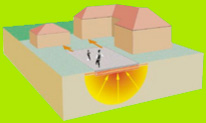Ten reasons to choose Interseasonal Heat Transfer
There are ten key reasons to choose IHT systems, which incorporate solar recharge of the ground and ground source heat pumps:
- IHT installations have very low running costs because they exploit the fundamental characteristic of the ground to act as an efficient store of thermal energy. In very cold weather, when heating is most needed, a ground source heat pump has access to warmer temperatures from the ground than an air source heat pump has from ambient air. IHT systems also attract the RHI.
- IHT exploits the Thermal Energy Storage capacity of the ground by recharging the ground with solar heat in summer. This allows GSHPs to be used efficiently at all hours of day and night in winter – this provides the opportunity to use GSHPs at night when electricity is cheaper.
- GSHPs do not suffer the problems of "intermittency" that effect renewable energy from wind turbines, photovoltaic cells or solar thermal panels. Indeed the Thermal Energy Storage capacity of the ground can be used to compensate for the intermittent supply of energy from other renewable sources.
- IHT provides one of the most economic routes to providing on-site renewable heating, reducing emissions of greenhouse gases and meeting the government's binding targets on renewable energy. It does this by integrating solar charging of the ground in summer and GSHPs to extract that heat from the ground in winter.
- Although IHT systems require upfront investment, the reductions in emissions of greenhouse gases are very great and an investment in IHT lasts much longer than other investments in renewable energy. The ground works installed for thermalbanks, a major part of the cost, can be expected to last for over 100 years. The ground source heat pumps themselves are very reliable pieces of equipment with a long life – longer than air source heat pumps. Air source heat pumps have to be located outside, they have more moving parts, including air circulation fans, and need to incorporate energy-consuming defrosting elements to contend with the formation of ice in winter. GSHP installations compare favourably with all other forms of Renewable Heating and all other mechanisms for generating Renewable Electricity in terms of life span.
- GSHP systems are good citizens: they are silent, free from polluting chemicals, reliable and invisible. They are welcomed by planning authorities and architects. They produce no carbon emissions on site, and none at all if powered by renewable electricity. There have never been any political objections to GSHP systems in the way that wind turbines have caused unrest and resentment and expensive government schemes on other technologies have raised eyebrows at the wisdom of excessive government spending.
- IHT systems offer the opportunity to recycle heat energy. Naturally occurring energy can be captured when it is freely available in the summer, stored in the ground over the autumn, and released to heat buildings in winter. This singular merit is attributable to use of the ground for Seasonal Thermal Energy Storage, which is an integral part of Interseasonal Heat Transfer.
- Unlike any other form of Renewable Technology the power of a heat pump can be reversed in summer to provide cooling.
In the case of an air source heat pump (or an air conditioning chiller) heat taken out of a building
in summer is merely "wasted" to the atmosphere.
It is a very expensive option to provide cooling by heat exchange
with hot air.
The radical, renewable cooling, alternative is to use a ground source heat pump to heat exchange
with cold ground: the primary
advantage is that it is much more efficient than heat exchanging with hot air.
The secondary advantage is that a by-product of renewable cooling is to deposit heat into the ground – in advance of the time in winter when the heat pump will be looking to extract heat from the ground. - Many forms of investment in renewable energy require imports as equipment like photovoltaic panels, wind turbines and solar panels come from abroad and provide employment abroad. Investment in sound ground source energy installations, which requires a detailed understanding of the local geology and local conditions, provides skilled employment in Britain for the local expertise in designing an appropriately sized system and local employment in installing the ground works.
- IHT systems contribute to the Energy Security of the UK by providing heating and cooling from energy which occurs naturally in the UK, instead of relying on imported fossil fuels.
- IHT systems improve Air Quality - unlike other space heating systems they release no CO2 on site, no NO2, no SO2, no particulate matter and no carbon monoxide.
See:
Ground Source Energy | Ground Source Heating | Ground Source Cooling
ICAX Projects:
Toddington
| Howe Dell
| Hiroshima
| HMP Garth
Suffolk One
| Merton
| Wellington
| Tesco Greenfield
Balanced Energy Networks
| Solar Energy Networks

